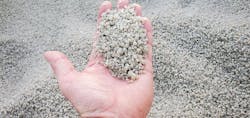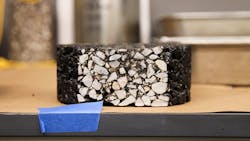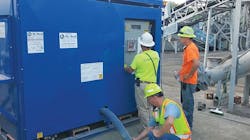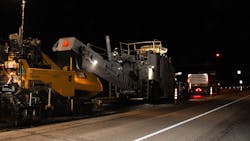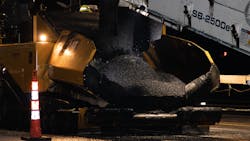By: Bill Buttlar, Ph.D., P.E.
In the U.S., 94% of the 2.6 million miles of paved roads are surfaced with asphalt. Over the last century, the strategies for designing asphalt pavements have involved two main factors—durability and cost. Currently, various environmental concerns have added new dimensions to pavement design, such as sustainability and resilience.
Asphalt pavements have proven to be an attractive destination for various recycled materials. The oldest and most common recyclate used in asphalt is reclaimed asphalt pavement (RAP). Ground tire rubber obtained from scrap tires is a popular additive in some regions, and more recently, post-consumer recycled plastics (PCR-P) have received significant national attention in the U.S. This article provides a summary of the laboratory and field demonstration projects underway in the state of Missouri that are exploring the feasibility of using PCR-P in asphalt pavements.
Motivating factors
The world is becoming increasingly littered in plastic waste. Take, for instance, the Great Pacific Garbage Patch (GPGP) in the Pacific Ocean. Twice the size of Texas and rapidly growing, it contains 80–100 million tons of plastic and an estimated 1.8 trillion plastic particles. Some other motivating factors and statistics for addressing plastic waste in the U.S. include:
- In 2015, plastics comprised about 13% of total municipal solid waste (MSW). The total plastic waste was 34.5 million tons, out of which only 3.1 million tons were recycled in the U.S.
- In Europe, about 30% of plastic waste is recycled.
- Plastics accounted for 12% of global waste in 2016.
- After reaching the oceans, plastics break down into small pieces leading to the mortality of an estimated 100,000 marine mammals and 1,000,000 seabirds annually.
One way to address the plastic waste problem is to increase recycling, but citizens are understandably skeptical about the time required to clean, sort, and collect plastics without knowing where the plastic is actually going and for what it is being used. Some undoubtedly suspect it is simply being combined with trash and landfilled, and probably for good reason.
Recycling plastic into asphalt roads can, in theory, take a large bite out of the plastic waste problem by providing a highly visible and understandable destination for plastic waste, thereby motivating people to collect and recycle plastics. Hundreds of millions of tons of asphalt are produced annually in the U.S. If we assume that a half-percent of plastic by weight of an asphalt mixture could be responsibly used, conceivably more than a million tons of plastic waste could be recycled into roads each year. Yet, not every plastic can be used in asphalt. For instance, polyethylene terephthalate (PET)—which is commonly used in clothing and beverage bottles—possesses a melting point that renders it unusable at even the highest practical asphalt production temperatures. In addition, neither polystyrene—which is used in plastic foam coffee cups—nor polyvinyl chloride (PVC)—which has a high melting point and is unsafe when heated—are suitable for use in asphalt. This leaves various types of polyethylene (PE) forms, which comprise about a third of annually produced plastics, and various mixes of PE or other low melting point plastics. These include HDPE, LDPE, and LLDPE, which are commonly used in bags, bottles, containers, wraps, toys, cable shielding, and many other applications. PE-rich mixtures containing small amounts of other plastic waste sources may ultimately provide the best balance between recyclability and economy when used in asphalt paving.
Can a quality asphalt mixture be made with plastic?
Before diving into the environmental and economic questions surrounding the use of plastic waste in asphalt, one must first prove that it works from a technological standpoint. In the world of asphalt mix design, this means that it must be mixable, compatible with other asphalt mixture components, and occupationally safe to use. Most research starts in a laboratory, because we must first prove that it is workable and meets prevailing mixture requirements. A review of the literature suggested that workable mixes were produced in India, France, Thailand, the U.K., New Zealand, and Australia. The majority of the projects reported in the literature focused on wet process modification, where the waste plastic is introduced into the liquid asphalt binder at a blending terminal and supplied to the contractor in a form akin to a polymer-modified binder. However, in Missouri, the approach taken so far is to pursue dry-process PCR-P mixture, with the primary motivator being the ability to use as much as 5 to 10 times more waste plastic as compared to the wet process.
After nearly three years of lab experience with the dry process with PCR-P modified mixtures, it is clear that high-quality asphalt mixtures can be achieved in the lab using the dry process. Applying modern, balanced-mix design (BMD) approaches, it has been demonstrated that PCR-P mixes can be developed that pass cracking, rutting, and moisture sensitivity requirements. Working with the Missouri Department of Transportation (MoDOT), the lab has shown that mixes with recycled plastic can be developed that pass current MoDOT BMD requirements. These involve both volumetric and performance tests requirements, such as those evaluated with the IDEAL Cracking Test (IDEAL-CT) and Hamburg Wheel Tracking Test. Those familiar with asphalt performance tests would appreciate that an IDEAL-CT index of approximately 80 with a Hamburg rut depth of less than 6 mm after 20,000 passes represents a good performing, dense-graded asphalt surfacing mix for use under moderate traffic conditions. Such results have been achievable using recycled LLDPE pellets as shown in Figure 1, which provided the necessary motivation to pursue a full-scale demonstration project on a portion of Stadium Boulevard, a four-lane state highway near the University of Missouri campus in Columbia, Missouri.
Can you build it?
Promising lab results notwithstanding, a leap of faith was required to undertake the full-scale demonstration project using the recycled PCR LLDPE pellets. In order to build confidence in the ability to dry-feed the LLDPE pellets into a modern, counterflow asphalt drum mix facility, the demonstration project first involved dry-feeding, mixing, laying, and compacting an engineered crumb rubber (ECR) product as the first experimental test section. Similar test sections have been built across Missouri and the U.S. in recent years with great success. By sending a half-ton sample of the LLDPE pellets to the manufacturer of a well-known fiber/rubber feeder system (Figure 2), it was determined that only minor modifications to the feeder system would be required to switch from feeding ECR into the asphalt plant to feeding the LLDPE pellets. This involved installing an additional restrictor plate to account for the higher flow characteristics of the slippery, plastic LLDPE pellets as compared to the more angular and textured GTR powder.
Three PCR-P mixtures were investigated in the MoDOT/University of Missouri Stadium Boulevard demonstration project, which was constructed in August 2021 by project partner Capital Paving Inc. The control mixture used across the remainder of the resurfacing project contained 30% reclaimed asphalt pavement and 30% recycled slag aggregate, along with a relatively stiff PG64-22V asphalt binder suitable for use on an urban corridor. The first experimental section (denoted as GTR) contained 10% ECR by weight of the binder, along with a neat (unmodified) PG58-28 binder. The three experimental sections containing waste plastic were comprised as follows:
- WP1: Contained 0.5% LLDPE by weight of the mixture (dry process) and PG58-22 binder
- WP2: Contained 0.25% LLDPE by weight of the mixture (dry process) and PG58-22 binder
- WP3: Contained 0.25% LLDPE by weight of the mixture (dry process) and PG58-22 binder modified with a virgin polymer/compatibilizer (thus constituting a ‘hybrid’ wet/dry process)
All experimental sections were at least 0.5 miles in length, with the GTR section spanning across 1.14 centerline miles. However, each experimental mixture was placed in both the outer driving lane and passing lane, thereby doubling the length of the sections in terms of lane-miles. All experimental sections contained 30% RAP and 30% slag, similar to the control mixture. The WP3 mixture had the best overall BMD test scores and did not require the use of a rejuvenating agent as compared to WP1 and WP2.
From a project management perspective, the contractor was able to achieve good density of the mixture in all of the experimental sections and control section. This success was possibly aided by the high air temperatures present at the time of construction. The control of the dry feed system was monitored in real time and later evaluated by examining the digital output of the data collected by the Hi-Tech feeder system and stored on a removable micro-SD card. With the exception of feed rates recorded immediately after start-up operations, both the dry process rubber and LLDPE plastic were found to have very consistent and accurate feed rates.
In terms of field performance, only time will tell how the experimental sections will ultimately compare to not only one another, but most importantly to the control section. A small amount of blistering was noted after construction mainly in the control section due to hot temperatures, moist conditions, and high mat density. No rutting was detected in any of the experimental sections or control section after a month of very hot summer days between mid-August and mid-September 2021. Halfway through the winter of 2021-2022, all sections are performing well, with just a few hairline reflective cracks noted in the control section and some of the experimental sections.
Is it sustainable?
At face value, diverting waste plastic from landfills and reducing the amount of virgin polymers required for high-performing asphalt mixtures would seem to be a slam-dunk in terms of increasing pavement sustainability. However, a rigorous evaluation will require a comprehensive, consequential Life Cycle Assessment (LCA) to be performed. In a nutshell, a consequential LCA can evaluate the overall environmental impacts (positive and negative) of an infrastructure development project (such as a road incorporating recycled plastic) relative to what would result if the road were built in a more traditional fashion (virgin polymer used, an equivalent mass of waste plastic following other trajectories). Energy, emissions, aquatic toxicity, and many other environmental factors must be quantified and compared before the sustainability benefits of PCR-plastic asphalt mixtures can be accurately evaluated.
Is it resilient?
Infrastructure resilience is a topic of growing concern, given the changing weather patterns noted by increasing rainfall intensities during storms, more extreme hot and cold temperature events, and an overall general trend towards increased global average temperatures. Recycled PCR-P asphalt mixtures might play several important roles in driving towards more resilient transportation infrastructure, including:
PCR-P asphalt mixtures can be formulated to perform well in both high- and low-temperature extreme events. Similar to traditional polymer-modified mixes, the use of recycled plastic (and thus recycled polymers) in asphalt can lead to mix designs that can endure the most extreme weather events.
Asphalt, in general, is fully recyclable and nearly all of the reclaimed asphalt pavement (RAP) milled from asphalt pavements is recycled and reused. Asphalt roads can be readily rebuilt after extreme events (hurricanes, floods, earthquakes), and the most durable roads (such as those containing polymers) can stand up to less devastating but nonetheless extreme events. Pavements containing recycled polymer can be milled and reintroduced as polymer-modified RAP similar to how pavements containing virgin polymers or GTR can be milled and reintroduced as a high-quality RAP product.
Is it cost effective?
Only time will tell if this solution is cost-effective. However, early indications are that mixed PCR-PE streams will be cost-competitive with virgin polymers, and with time, much less costly. A similar trend has been noticed with wet-process vs. dry-process GTR. The advent of newer, dry-process GTR technologies has simplified the process of introducing larger amounts of recycled rubber into pavements as an alternative to virgin polymer, while reducing the cost of creating a high-performance mix. Likewise, as PCR-P recycling infrastructure expands and mixed-PE products emerge, dry-process PCR-P mixes are expected to be highly cost competitive. For local roads, the high toughness of GTR and PCR-P mixes opens the door for the use of ‘thin-lay’ type overlays, which reduce virgin material usage and cost without sacrificing overlay longevity.
What’s next?
Although the use of waste plastic in asphalt is quite promising, more work is needed to fully evaluate the durability, sustainability, resilience, and economics of these novel asphalt paving mixtures. A more comprehensive demonstration project involving eight experimental mixtures will be placed on I-155 in Pemiscot County, Missouri in late 2022 or early 2023. The research will be in collaboration with the National Road Research Alliance (NRRA), and will also evaluate the role of BMD and modern recycled additives in slowing down the rate of reflective cracking in asphalt overlay systems. One of the key features of the Pemiscot County project will be the evaluation of a more locally sourced, mixed plastic waste stream.
From a qualitative standpoint, the recent media attention surrounding the Stadium Boulevard demonstration project and similar demonstrations around the world indicates that citizens and engineers alike are excited about the environmental benefits of large-scale recycling of plastic waste into asphalt pavements.
About The Author: Buttlar is Glen Barton Endowed Chair in Flexible Pavement Systems and director of the Missouri Center for Transportation Innovation at the University of Missouri-Columbia.
